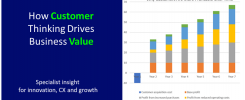Much of my long working life has been spent at the sharp and unforgiving edge of innovation. I worked on the dawn of digital photography for Kodak and the introduction of direct banking for Barclays. I was involved with commercialising most of Vodafone Global’s B2B technology and worked on start-ups like Home Halo and the fintech Property Master.
So what have I learned, and how can you avoid the common mistakes?
#1 The Whirlwind Accelerates
It is clear that right now we are entering a new and even faster Phase 2 of digital-led innovation and this is challenging incumbents and start-ups alike. New, transformational technologies such as 5G mobile, Blockchain, 3D printing, intelligent automation, AI and IOT are all here and now. At the same time digital native businesses such as Facebook, Amazon, Apple, Netflix and Google have endless investment cash, capability and ambition. The millennium generation of consumers are also digital natives whose expectations for convenience, functionality and ethical value appear fundamentally radical. B2B buyers have expectations of the speed and functionality they experience in their consumer lives and this is challenging traditional supply chains.
You don’t have to be a jeans and tee-shirt technology-based firm to capitalise on these insights, they apply equally to traditional, established nitty-gritty businesses who are transforming their processes, products, relationships and thereby increasing value for their customers.
Most importantly Phase 2 of digital transformation is enabling fundamentally different business models able to combine customer intimacy and operational excellence and product innovation in a direct challenge to traditional market leaders.
#2 Innovation is the most challenging business activity.
Despite the imperative to innovate; the availability of investor funds, the new digital tools and endless new market opportunities successful innovation remains the most challenging of all business activities.
Corporates have been slow to respond to digital challenges and take the lead in markets that are their heartland and despite the starry-eyed dynamism of start-ups most (90% -Forbes) falter or fail. Why is this? One reason is that start-up entrepreneurs and corporate champions are too often so fixated on new product and service features that they are convinced will be world beating that they avoid talking to their potential customers to confirm or develop their thinking.
The Lean Start-up (Eric Ries) approach explains that a start-up is in a race to find a sustainable business model before their cash runs out. All too often the entrepreneur is so sure that they have a world beating business idea that they race to build their imagined perfect solution, burning their investor’s cash before discovering that customers want something else. Lean Start-up advocates market testing simple low cost “throw away” hash-ups (minimum viable product) to learn directly from customers and “pivoting” to a solution with proven demand before committing to build and launch.
Early investors (and corporate leaders responding to shareholder demands) are often at fault for demanding unrealistic business plans showing astonishing growth and financial return encouraging entrepreneurs to press blindly towards disaster fully convinced customers will come. Until the business model is proven these plans are meaningless other than as hypotheses to test, learn and change.
The recognition that the new business will have to pivot – probably several times – as it evolves rapidly in the race to find market traction while the cash lasts demands agility based on small customer focussed teams, micro components offering flexible modularity and digital platforms enabling direct customer feedback, automated response and – once the model is proven – rapid scaling. There are established techniques for digital development using Agile and Design Thinking that help to align the build to customer expectation, while maintaining pace. All too often businesses persist with slow and rigid “waterfall” sequential builds based on internally developed service definitions.
Interestingly later stage investors and private equity firms are expert at the rapid interrogation of market proven business plans to establish the customer value proposition, management competence and operational model in deciding whether to invest for growth.
#3 Successful Innovation Improves Customer Value.
Fundamentally successful innovation is about identifying ways to improve customer value. What they value is what they are paying for, and why they will buy and come back. It’s the customer’s choice to buy based on their assessment of what is valuable to them. So you can’t assume you know best on their behalf, you have to get close to customers and really understand their value assessment before you design and build your offer, both in its components, and holistically in context.
BeyondCuriosity are experienced at helping innovators establish the elements of customer value through collaborative design where prospective customers are involved with the business to identify and design valued elements and a mutually beneficial, commercial solution. Taking this deep understanding and aligning it to the client business model to develop an achievable and compelling growth strategy is the essence of Customer Thinking.
What is valued by customers will no doubt include functional aspects of product and service, such as speed, cost and accuracy. These may sound like the most important things to get right, and it is true that they are typically the table stakes. Business leaders and entrepreneurs like these elements because they are often the direct outcomes of digitising processes so appear straightforward to build and easy to measure. But for customers they are often just hygiene factors for a transactional purchase with no engagement or value-add. In fact, if you don’t check carefully with the customer you may over-engineer and be wasting effort improving performance aspects that are not noticed or important to the customer.
An even greater level of customer value and long-term financial return to the business may come from building a customer experience centred proposition. The smartest businesses know that the warmest, highest spending customers may value a range of more intangible elements in addition to the rational, tangible delivery components, and this is just as true for business customers as it is for consumers.
The customer makes their value assessment based on the whole experience, before and during purchase, and in use. This holistic experience is the value proposition, and explains why digital UX, which is the design of interfaces to be simple and effective to use, and Customer Experience a discipline measuring and improving the customer’s contact experiences at every part of their journey, are so important.
#4 How Customer Thinking Drives Successful innovation
Successful innovation requires Customer Thinking from the outset to identify where value is being created and develop a compelling customer value proposition. The initial concepts can be informed and developed through direct dialogue with prospective customers and industry experts. Customers typically enjoy these conversations and can be surprisingly creative and informed, indeed established B2B businesses should look to form strategic partnerships with core customers to jointly develop solutions.
There are a cluster of methodologies that are effective at this stage of co-creation and customer value identification. In particular entrepreneurs should consider observing customers in context through simple versions of ethnography or “deep dive”, breaking the overall customer journey down into stages and thinking how each stage adds or subtracts value and paying particular attention to “nay-sayers”. Entrepreneurs often gloss over objections from experts and prospective customers, but working hard to really understand what lies underneath objections is worth a fortune through avoiding misadventure, or as rocket fuel to deep innovation.
Additional techniques of qualitative and quantitative research enable business plans and financial projections to be placed on a sound footing giving confidence to investors and entrepreneurs to proceed.
While taking these first steps the deep experience that BeyondCuriosity bring is invaluable in helping to nurture tender shoots of ideas while keeping a sober outside-in perspective.
Although at the early stages of proposition development, and the creation and testing of a minimum viable product direct customer dialogue is essential digital businesses should bake into their DNA a customer centricity that is 360 degrees and cross-functional. Digital data should be customer centred not product centred so the young business intercepts in real time customer behaviour and uses agile technology to flexibly adjust the value proposition.
#5 Customer as Profit Centre – Not the Product.
Entrepreneurs often believe that the innovative product or service is the core of the new business. But in reality customers are the profit centre. Smart businesses know that the strongest source of growth and profit is the customer not the product. This is because a customer who is fully engaged with the business will provide extra sales, more use, more spend and longer tenure. In fact they may become advocates and recruit customers for you. The new product or service is just one part of a rounded value proposition which engages customers and for which they provide the embryonic business with commercial viability.
Spend to build customer engagement is not a cost, it is an investment in future value. This is Customer Thinking.
#5 The Founders’ Curse and Digital Marketing Myopia
The first and primary barrier is a lack of customer focussed leadership which fails to embed from the outset a customer culture. This is the “founders curse” because entrepreneurs are so often fixated by their product concept that they are unable to slow down and really listen (to anyone, but especially to prospective customers). Only later, when prompted by disappointing sales or by investors do they recognise the absolute necessity of customer insight. By this time the cash has gone, and the customer is not baked into the culture.
You might think the marketing function should lead customer centricity but the current breed of digital marketeers have learned their craft through Phase 1 technologies and acquisition models such as website content and e-commerce design, SEO, social media, Google pay per click, CRM, database mailing. The paradigm here is rapid champion/challenger testing with digital data performance management (even hands-off marketing automation and CRM) exemplified by little or no understanding of the customer, and little or no creativity. This means Phase 1 digital marketeers lack the skills and experience needed to champion customer centred design in Phase 2 business models and this leading-edge Customer Thinking expertise may need to be brought in from outside to counter “digital marketing myopia”.
If you would like to learn more, call or e-mail 07957686366 chris.little@beyondcuriosity.com



